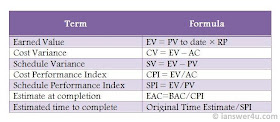Register now or log in to join your professional community.
<p>Please state the definition and how do you implement it? </p>

It is a forecasting/estimating tool used to measure the performance of the project progress, cost and schedule, at any time. It requires identifying three variables: Planned Value (PV), Earned Value (EV), and Actual Cost (AC), so we can determine the cost variance (CV), and the schedule variance (SV) as follows:
CV = EV - AC,
SV = EV - PV

Earned Value Management measures progress against a baseline. It involves calculating three key values for each activity in the WBS:
These three values are combined to determine at that point in time whether or not work is being accomplished as planned. The most commonly used measures are the cost variance:
Cost Variance (CV) = EV - AC
and the schedule variance:
Schedule Variance (SV) = EV - PV
These two values can be converted to efficiency indicators to reflect the cost and schedule performance of the project. The most commonly used cost-efficiency indicator is the cost performance index (CPI). It is calculated thus:
CPI = EV / AC
The sum of all individual EV budgets divided by the sum of all individual AC's is known as the cumulative CPI, and is generally used to forecast the cost to complete a project.
The schedule performance index (SPI), calculated thus:
SPI = EV / PV
is often used with the CPI to forecast overall project completion estimates.
A negative schedule variance (SV) calculated at a given point in time means the project is behind schedule, while a negative cost variance (CV) means the project is over budget.

EVM used in measure of project performance and also in project status report

Earned Value Management is one of the most common techniques used to measure the performance of the ongoing project. To implement earned value analysis in project management, it is important to first understand the following EVA terms and formulae. Planned Value (PV):Also called Budgeted Cost of Work Scheduled(BCWS), is the cost that is proposed to be utilised on an activity during a specific time frame.Actual Cost (AC):Also called Actual Cost of Work Performed(ACWP), is the aggregate cost that is spent on an activity while its execution, during a specific time frame.Rate of Performance (RP):It is the rate at which the project is progressing. Mathematically, it is the percentage of the work actually completed out of the total work that was scheduled to be completed till that point of time.Earned Value (EV):Also called Budgeted Cost of Work Performed(BCWP), is the estimate of the value of the work completed, on the basis of how much work should have been completed and how much work was actually completed.EV = PV X RP






Do you need help in adding the right keywords to your CV? Let our CV writing experts help you.